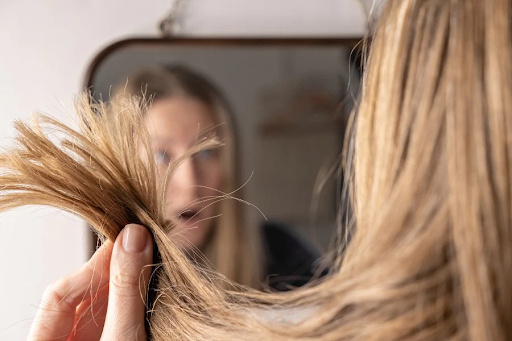Table of Contents
- Split Ends 101: Why They Happen
- The Cost of Ignoring Them: From Frizz to Breakage
- How to Prevent Split Ends: The Pro Secrets
- Upgrade Your Styling Routine
- Hydrate Like a Pro
- Trim With Purpose — Don’t Skip It
- Night Care Is Hair Care
- Be Gentle With Wet Hair
- Pro Tip: Use a Split End Mender or Tool
- How Often Should You Trim to Prevent Damage?
- Hair Health From the Inside Out
- What to Avoid: The Split-End Sins
- Quiz: How Healthy Are Your Ends?
- FAQs
- Quick Recap Checklist
Split ends are every hair lover’s nightmare. One moment, you’ve got sleek, soft strands, the next, your ends look like straw. And if you’ve ever felt like your styling routine might be the culprit, you’re not wrong. But here’s the truth: you don’t have to sacrifice your favorite looks to maintain healthy hair. With a few pro tricks, you can stop split ends in their tracks while still enjoying blowouts, curls, or color.
Split Ends 101: Why They Happen
To fix a problem, you need to understand it. Split ends — also known as trichoptilosis — occur when the protective outer layer of your hair (the cuticle) wears away due to damage. This exposes the inner cortex, causing the ends of your hair to split like a frayed rope.
So what causes split ends? The main culprits are:
- Heat styling without protection
- Chemical treatments like bleaching and perms
- Overwashing with drying shampoos
- Mechanical damage from rough brushing or towel drying
Each of these weakens the hair’s structure over time, making strands more prone to breaking or splitting. The good news? Understanding what causes split ends is the first step in learning how to prevent split ends long term.
The Cost of Ignoring Them: From Frizz to Breakage
If you think you can let split ends slide, think again. Left untreated, they travel upward, damaging more of your hair and leading to:
- Increased breakage
- Visible frizz and flyaways
- Uneven texture and thinning
- Difficulty growing your hair past a certain length

Symptoms Checklist:
These are classic signs of hair with split ends that should be addressed early.
-
Hair feels rough at the ends
-
You notice white dots on the tips
-
Curls aren’t forming properly
-
You see Y, T, or feather-shaped ends
By catching these early, you can address the damage before it spreads.
How to Prevent Split Ends: The Pro Secrets
Preventing split ends isn’t about luck — it’s about the right habits. Here’s how to protect your strands like a pro:
1. Upgrade Your Styling Routine
Styling doesn’t have to destroy your hair — especially when you learn how to prevent hair breakage through smart habits.
- Always use a heat protectant spray or serum before using flat irons, curling wands, or blow dryers.
- Lower your heat setting — high temperatures aren’t always necessary.
- Limit heat styling to 1–2 times a week max.
Keywords to remember here: how to prevent hair breakage, split ends curly hair. Curly hair is even more prone to breakage, so heat-free styles like twist-outs or braids are a gentler option.
2. Hydrate Like a Pro
Hydrated hair is less likely to split. Treat it like skincare:
- Use deep conditioning masks weekly.
- Look for ingredients like keratin, coconut oil, shea butter, and panthenol.
- Seal in moisture with lightweight oils like argan or jojoba.
Try layering a protein-based mask first, followed by a moisture-rich one for balance.
3. Trim With Purpose — Don’t Skip It
Skipping trims allows damage to climb up your hair shaft. But that doesn’t mean you need to lose length:
- Use a split end trimmer like the Mini 2 or Pro2 to snip only the broken ends.
- This tool is like a “straightener that cuts split ends” without taking off inches.
- It’s ideal for maintaining growth while minimizing damage.
🔗 How to Cut Split Ends at Home
4. Night Care Is Hair Care
What you do while you sleep matters.
- Swap out your cotton pillowcase for silk or satin to reduce friction.
- Braid or bun your hair loosely to avoid nighttime tangling.
- Apply a small amount of leave-in or oil to seal in moisture overnight.
This step is especially important if you’re working to repair curly or fragile hair. This night care routine also benefits split ends in curly hair, which needs extra moisture and low-friction rest.
5. Be Gentle With Wet Hair
Wet hair is at its weakest. Handle with care to avoid developing dead ends in hair that leads to breakage.
- Use a wide-tooth comb — never a brush — on wet strands.
- Apply a leave-in conditioner before detangling to soften knots.
- Start from the ends and work upward.
6. Pro Tip: Use a Split End Mender or Tool
The best-kept secret among hair pros? A split end mender — or even better, a trimmer.
Tools like the Split Ender Mini or Pro2 are designed to remove only the damaged ends without chopping off healthy length.
Scissors vs. Trimmer Comparison:
|
Method |
Length Cut |
Skill Needed |
Speed |
Precision |
|
Scissors |
1–3 inches |
High |
Slow |
Manual |
|
Split End Trimmer |
~1/4 inch |
Low |
Fast |
Automatic |
These tools are game-changers for anyone growing out their hair or trying to avoid the salon.
How Often Should You Trim to Prevent Damage?
You don’t need a drastic chop every month. A light trim every 6–8 weeks is usually enough to keep damage at bay. If you’re using a split end trimmer at home, you can even do quick passes more frequently — every 3–4 weeks for maintenance.
Pro Tip: Practice “dusting” — trimming only the very ends — to preserve your style and length.
Hair Health From the Inside Out
Your hair reflects what’s going on inside your body. To strengthen it from the root:
- Eat foods rich in biotin, omega-3 fatty acids, zinc, and protein
- Stay hydrated
- Consider a hair-targeted supplement if needed
This step is crucial for anyone learning how to have healthy hair and achieve lasting strength and shine.
What to Avoid: The Split-End Sins
Even the best routine can be undone by common mistakes. Here are the top habits to ditch:
❌ Sulfate-laden shampoos — they strip your hair’s natural oils
❌ Towel rubbing — rough drying causes friction and frizz
❌ Tight hairstyles — buns or ponytails that pull too tightly
❌ Overwashing — removes natural moisture and weakens strands
Keep these in mind to protect all the work you’re putting in. Avoiding these habits is the difference between split ends vs healthy hair
Quiz: How Healthy Are Your Ends?
Take this quick quiz to find out if your hair’s in good shape — or if it’s time to take action.
1. How often do you use heat tools (flat irons, curlers, blow dryers)?
A) Almost every day
B) A few times a week
C) Rarely or never
2. When was your last trim?
A) Over 3 months ago
B) 6–8 weeks ago
C) Within the last month
3. Do your ends feel rough or look frayed?
A) Yes, definitely
B) Sometimes
C) Not at all
4. Do you use a deep conditioner or hair mask weekly?
A) No
B) Occasionally
C) Yes, consistently
5. What kind of pillowcase do you sleep on?
A) Cotton
B) Sometimes silk
C) Silk or satin every night
Results:
- Mostly A’s – Split end emergency! Your ends need immediate TLC. Start with a trim and build a weekly care routine.
- Mostly B’s – Some good habits, but there’s room for improvement. Add consistency to your routine.
- Mostly C’s – You’re doing great! Keep up the routine and consider adding a trimmer for maintenance.
FAQs
What causes split ends?
Heat styling, chemical treatments, overwashing, and mechanical damage are the primary causes.
Can I fix split ends without cutting them?
You can temporarily seal them with menders, but to truly remove split ends, trimming is required.
What is the best product for split ends?
Looking for the best product for split ends? Choose deep conditioners, natural oils, and precision tools like a split end trimmer.
How do I prevent split ends in curly hair?
Hydration is key — use deep conditioners, avoid over-manipulation, and detangle gently.
Are split end trimmers safe for regular use?
Yes, they’re designed for light, frequent use and help maintain hair health without major cuts.
Quick Recap Checklist
- Spot the signs of damage early
- Use heat protection every time
- Hydrate weekly with masks
- Sleep smart with silk pillowcases
- Detangle gently when wet
- Trim every 6–8 weeks (or dust more often)
- Feed your hair with good nutrition
- Avoid sulfate shampoos and tight styles
- Try a split end trimmer for easy maintenance




